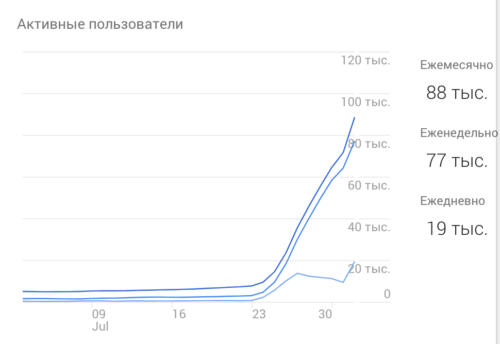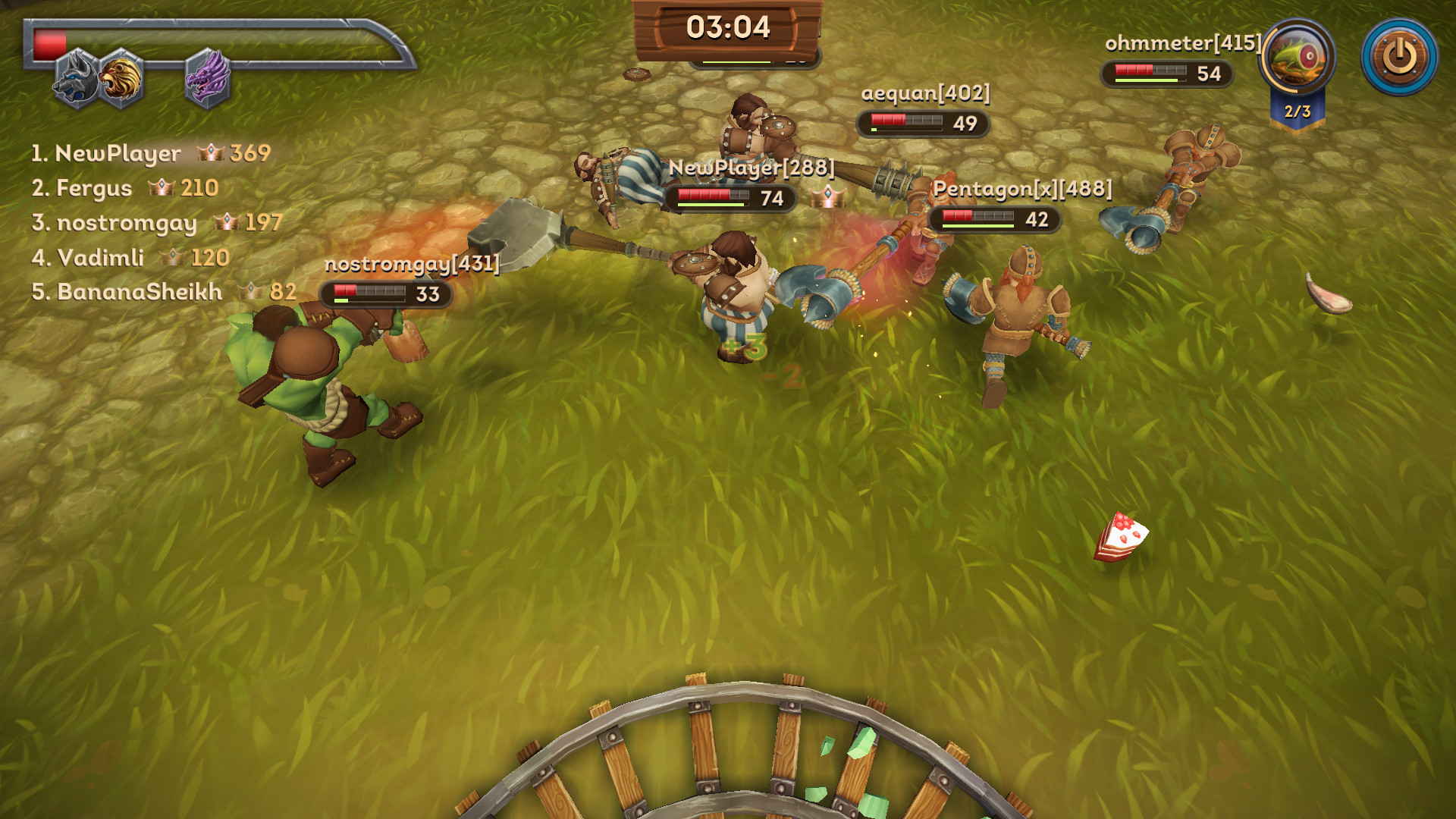In August last year, independent developer Alexander Simakhin released the Slash Arena MMO game he made alone as a WebGL application on social networks. Today, August 3, 2017, the game was released on Steam in early access. App2Top.ru I asked Alexander about the fate of the project and whether it is now possible to create games alone and earn money from it.
Simahina’s Slash Arena is an online minimalistic brawler in which the player controls a Viking running around the arena. The task of the game is to defeat all the other players on it, spinning a healthy axe around them.
Initially, the game was close in spirit to io releases, like Slither.io and Agar.io , but as the project develops, it becomes more complex. He began to divide into five-minute sessions, got pumping characters and monetization.
Alexander Semenov, Senior Editor App2Top.ru : A year ago, at the pre-launch stage, you reported a total MAU of 15 thousand users across web platforms. The game has changed a lot since then. How much did you manage to raise the metrics and monetization of the project, if we talk only about the web?
Alexander Simakhin
Alexander Simakhin, founder of Drunken Monday: MAU has grown a lot and continues to grow, this can be seen on the chart below.
Retention of 1 and 7 days turned out to be raised 1.5 times when switching to a new pumping system and session fights that last 5 minutes. Previously, the game had an endless mode.
Monetization on Facebook and VK has grown by about 30%, but, in general, it is very lame on the web, since not all platforms support IAP.
By supporting web versions, you also moved towards the native almost from the very beginning. You have mobile apps, now there is a version for Steam. Is it really necessary, something like the implementation of the “with the world by the thread” strategy?
Simakhin: An indie developer should always try to take advantage of the maximum opportunities.
Access to numerous platforms gives not only additional income, but also free or cheap traffic.
Considering that I’m making a game on Unity, which provides the ability to quickly integrate third-party platforms, it was strange not to take it up.
A year ago in your post you shared that the main difficulty in development was related to the performance of WebGL. What turned out to be the most difficult already when porting the game to native, both on PC and mobile?
Simahin: WebGL has remained the main problem, it causes huge inconvenience during development.
This is due to 2 things: performance (in the web, the WebGL version of the game works several times slower than the Steam version) and the complexity of debugging.
The easiest thing is to make the game on PC, a little more difficult – for mobile. Why is it a little more complicated? It’s all about the lower performance of smartphones compared to PCs.
You launched the web version of Slash Arena on the web last August. In December, closed testing on Steam began. You seem to have tested everything on the web at that time, why did you have a test and why did you spend so much time in it?
Simahin: It was necessary to look at the reaction of the players, at how the game works on different PCs. Testing on the web does not guarantee error-free operation on a PC at all. For example, there are still problems with certain versions of Linux.
What did closed testing on Steam give in terms of downloads, and what in terms of feedback?
Simahin: We had 5 thousand keys for the closed beta and we made a special page on our website, leaving the mail on which the player received a letter with a link to the key.
Somewhere around 10-30 keys diverged per day, so it lasted a week. Until they found out about it on Reddit. Then, within 2 days, all the remaining keys were gone.
From the point of view of feedback, in fact, it is not enough. People activated the keys, played and wrote almost nothing in the steam community.

Why go to early access after closed testing, which, as it always seemed to me, implies that the game is raw and needs to be run-in?
Simahin: Technically, the game is debugged, but we still don’t have enough content for a full version of the game, as I believe. Over the next 3 months, we will supplement the game with new characters and maps.
Around the same time as the launch of the web version of the game, you participated in the Google Play program, which gives a feature to projects at the beta stage. How was it useful and how hard was it to get there?
Simahin: It was necessary to send a request for a feature, which I learned about from your website. I don’t know what percentage of applications were successfully registered, but I got there. In my case, everything turned out quite simply.
How is it useful?
It turned out to debug 99% of the problems that would have arisen at the start of the game, the most specific problems.
For example, certain players with certain mobile operators did not have payments.
During the beta tests, it turned out to make good money, all payments from them go to the developer’s pocket.
July-August was the final launch season for the project. The game is officially released on Google Play, iOS, Facebook Gameroom and Steam. Why are you launching the game on all platforms right now?
Simahin: The goal was to release an MVP – minimal viable product. A project debugged with a minimum amount of content, in which you can constantly add new things and features and develop.
I originally planned to launch before September, since at this time major developers are starting to enter the market and the chance of getting lost for my game is extremely high. As soon as I managed to debug the whole game and make the initial content for it, I sent the game to the stores.
By the way, on the Apple mobile platform, the project reached the top in Russia. Did you do any work in this direction, or is it all a feature?
Simahin: There was no feature in iOS. I managed to contact the Apple Promotion team only 2 days after the launch, so I agreed with them to review the game for a feature when it goes into a worldwide launch. Getting to the top is the work of our marketing.
Another platform on which you have been highlighted is Facebook Gameroom. Why did they go to it? And was there any point at all, looking back at the result?
Simahin: As I have already said, in order for indie to survive, it is necessary to realize the maximum of possibilities. For us, Gameroom was one of them.
Since the platform is just developing, it turned out to be quite easy to get a feature: I contacted the manager from Facebook by mail, briefly told about the game and why it should be made. All.
Now we receive 1.5 – 2.5 thousand installations a day, payments are also coming.

If we talk about the results of mobile and Facebook Gameroom, not the web, then how is the project doing now?
Simahin: Everything is still ahead, we plan to storm the tops of Google Play and iOS this weekend.
Today it is planned to be placed in the VK mobile catalog in the “New” section. I hope that this will give a good increase in traffic on mobile. In addition to all this, we plan to invest well in marketing and reach the tops.
Once they started talking about the results. A year ago, you estimated the budget of the game at $3 thousand, which was spent on 3D models, sounds, graphics for interfaces, as well as food and accommodation. How much did it cost to polish and publish the game on more platforms?
Simakhin: Now everything has gone like an adult, I already work full-time with my partner, there are employees connected to tasks, the schedule was almost completely redrawn from scratch from freelancers, I had to buy more servers and, in general, expenses increased. Over the past year, they have approximately amounted to $60 thousand.
Have you managed to recapture it yet?
Simahin: It has not been possible to recapture yet, now the momentum is only increasing, I hope the game will pay off in the near future. As can be seen from the graph just below the total online players, the trend is positive.
What will happen next with the project and what is the team going to do?
Simahin: The project will develop in content and functionality, we plan to introduce team battles, new characters, skills, cooperative PvE and a bunch of other interesting things. As soon as there is an opportunity to increase the team, we will think about the next title.
On Steam, the game is not distributed for free, as on other platforms, but comes out as a premium product for $ 4.99 (129 rubles for Russia). Why such a pricing policy?
Simahin: We thought that Steam might be cool about a project with freeplay monetization, regardless of the game itself, so we decided to experiment.
We have completely removed frituplay from the game and made a premium product out of it. In the Steam version, we completely removed the waiting timers during the production of weapons / armor, increased the loss of resources at times, and also give the novice player an additional $20 gold (the amount players would pay for it when playing on other platforms). So the user on Steam will not have problems with in-game resources and will only enjoy the game.
Plus, for players with old hardware, whose web version of the game is slowing down or not going, the Steam version will fly.
And we also give out keys. Unsubscribe who is interested.





